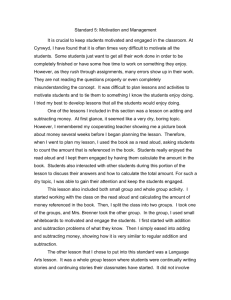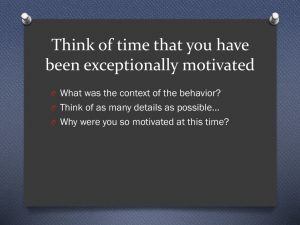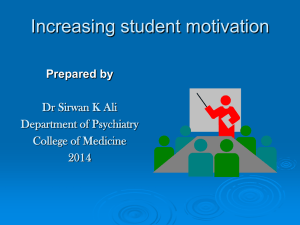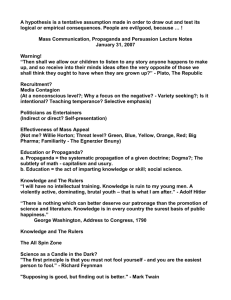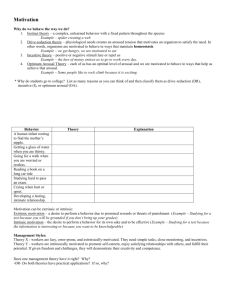21 Pointers - Suffolk Maths
advertisement
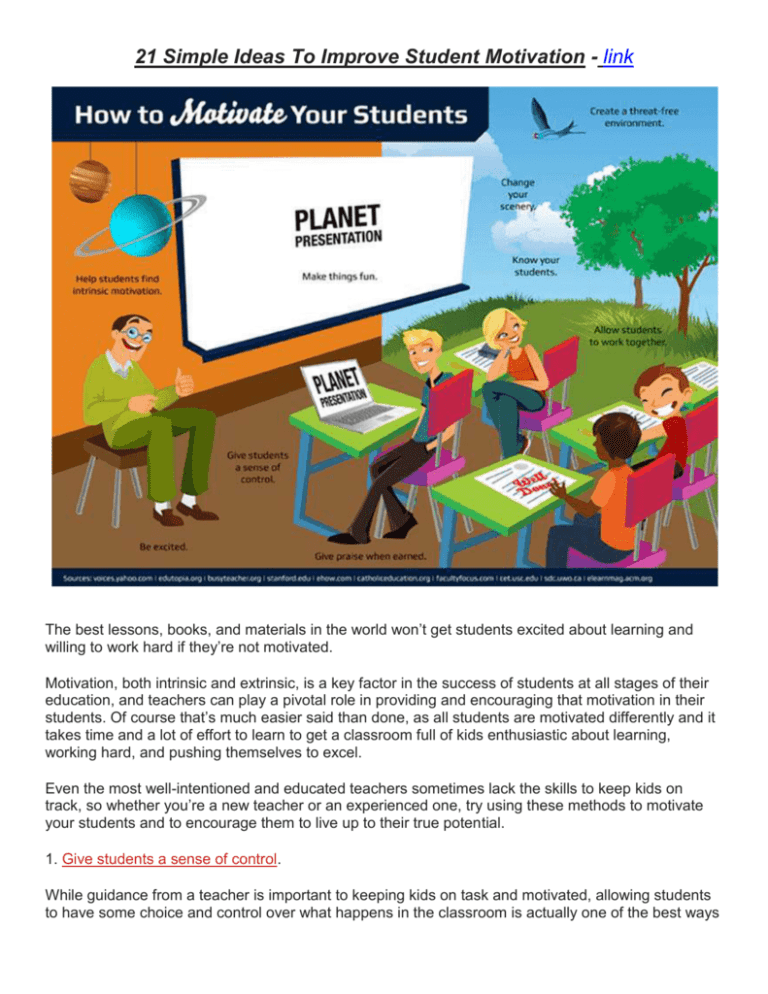
21 Simple Ideas To Improve Student Motivation - link The best lessons, books, and materials in the world won’t get students excited about learning and willing to work hard if they’re not motivated. Motivation, both intrinsic and extrinsic, is a key factor in the success of students at all stages of their education, and teachers can play a pivotal role in providing and encouraging that motivation in their students. Of course that’s much easier said than done, as all students are motivated differently and it takes time and a lot of effort to learn to get a classroom full of kids enthusiastic about learning, working hard, and pushing themselves to excel. Even the most well-intentioned and educated teachers sometimes lack the skills to keep kids on track, so whether you’re a new teacher or an experienced one, try using these methods to motivate your students and to encourage them to live up to their true potential. 1. Give students a sense of control. While guidance from a teacher is important to keeping kids on task and motivated, allowing students to have some choice and control over what happens in the classroom is actually one of the best ways to keep them engaged. For example, allowing students to choose the type of assignment they do or which problems to work on can give them a sense of control that may just motivate them to do more. 2. Define the objectives. It can be very frustrating for students to complete an assignment or even to behave in class if there aren’t clearly defined objectives. Students want and need to know what is expected of them in order to stay motivated to work. At the beginning of the year, lay out clear objectives, rules, and expectations of students so that there is no confusion and students have goals to work towards. 3. Create a threat-free environment. While students do need to understand that there are consequences to their actions, far more motivating for students than threats are positive reinforcements. When teachers create a safe, supportive environment for students, affirming their belief in a student’s abilities rather than laying out the consequences of not doing things, students are much more likely to get and stay motivated to do their work. At the end of the day, students will fulfill the expectations that the adults around them communicate, so focus on can, not can’t. 4. Change your scenery. A classroom is a great place for learning, but sitting at a desk day in and day out can make school start to seem a bit dull for some students. To renew interest in the subject matter or just in learning in general, give your students a chance to get out of the classroom. Take field trips, bring in speakers, or even just head to the library for some research. The brain loves novelty and a new setting can be just what some students need to stay motivated to learn. 5. Offer varied experiences. Not all students will respond to lessons in the same way. For some, hands-on experiences may be the best. Others may love to read books quietly or to work in groups. In order to keep all students motivated, mix up your lessons so that students with different preferences will each get time focused on the things they like best. Doing so will help students stay engaged and pay attention. 6. Use positive competition. Competition in the classroom isn’t always a bad thing, and in some cases can motivate students to try harder and work to excel. Work to foster a friendly spirit of competition in your classroom, perhaps through group games related to the material or other opportunities for students to show off their knowledge. 7. Offer rewards. Everyone likes getting rewards, and offering your students the chance to earn them is an excellent source of motivation. Things like pizza parties, watching movies, or even something as simple as a sticker on a paper can make students work harder and really aim to achieve. Consider the personalities and needs of your students to determine appropriate rewards for your class. 8. Give students responsibility. Assigning students classroom jobs is a great way to build a community and to give students a sense of motivation. Most students will see classroom jobs as a privilege rather than a burden and will work hard to ensure that they, and other students, are meeting expectations. It can also be useful to allow students to take turns leading activities or helping out so that each feels important and valued. 9. Allow students to work together. While not all students will jump at the chance to work in groups, many will find it fun to try to solve problems, do experiments, and work on projects with other students. The social interaction can get them excited about things in the classroom and students can motivate one another to reach a goal. Teachers need to ensure that groups are balanced and fair, however, so that some students aren’t doing more work than others. 10. Give praise when earned. There is no other form of motivation that works quite as well as encouragement. Even as adults we crave recognition and praise, and students at any age are no exception. Teachers can give students a bounty of motivation by rewarding success publicly, giving praise for a job well done, and sharing exemplary work. 11. Encourage self-reflection. Most kids want to succeed, they just need help figuring out what they need to do in order to get there. One way to motivate your students is to get them to take a hard look at themselves and determine their own strengths and weaknesses. Students are often much more motivated by creating these kinds of critiques of themselves than by having a teacher do it for them, as it makes them feel in charge of creating their own objectives and goals. 12. Be excited. One of the best ways to get your students motivated is to share your enthusiasm. When you’re excited about teaching, they’ll be much more excited about learning. It’s that simple. 13. Know your students. Getting to know your students is about more than just memorizing their names. Students need to know that their teacher has a genuine interest in them and cares about them and their success. When students feel appreciated it creates a safe learning environment and motivates them to work harder, as they want to get praise and good feedback from someone they feel knows and respects them as individuals. 14. Harness student interests. Knowing your students also has some other benefits, namely that it allows you to relate classroom material to things that students are interested in or have experienced. Teachers can use these interests to make things more interesting and relatable to students, keeping students motivated for longer. 15. Help students find intrinsic motivation. It can be great to help students get motivated, but at the end of the day they need to be able to generate their own motivation. Helping students find their own personal reasons for doing class work and working hard, whether because they find material interesting, want to go to college, or just love to learn, is one of the most powerful gifts you can give them. 16. Manage student anxiety. Some students find the prospect of not doing well so anxiety-inducing that it becomes a self-fulfilling prophecy. For these students, teachers may find that they are most motivated by learning that struggling with a subject isn’t the end of the world. Offer support no matter what the end result is and ensure that students don’t feel so overwhelmed by expectations that they just give up. 17. Make goals high but attainable. If you’re not pushing your students to do more than the bare minimum, most won’t seek to push themselves on their own. Students like to be challenged and will work to achieve high expectations so long as they believe those goals to be within their reach, so don’t be afraid to push students to get more out of them. 18. Give feedback and offer chances to improve. Students who struggle with class work can sometimes feel frustrated and get down on themselves, draining motivation. In these situations it’s critical that teachers help students to learn exactly where they went wrong and how they can improve next time. Figuring out a method to get where students want to be can also help them to stay motivated to work hard. 19. Track progress. It can be hard for students to see just how far they’ve come, especially with subjects that are difficult for them. Tracking can come in handy in the classroom, not only for teachers but also for students. Teachers can use this as a way to motivate students, allowing them to see visually just how much they are learning and improving as the year goes on. 20. Make things fun. Not all class work needs to be a game or a good time, but students who see school as a place where they can have fun will be more motivated to pay attention and do the work that’s required of them than those who regard it as a chore. Adding fun activities into your school day can help students who struggle to stay engaged and make the classroom a much more friendly place for all students. 21. Provide opportunities for success. Students, even the best ones, can become frustrated and demotivated when they feel like they’re struggling or not getting the recognition that other students are. Make sure that all students get a chance to play to their strengths and feel included and valued. It can make a world of difference in their motivation.
